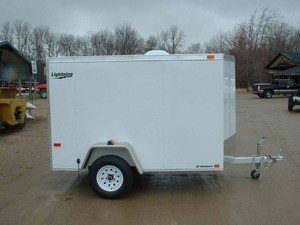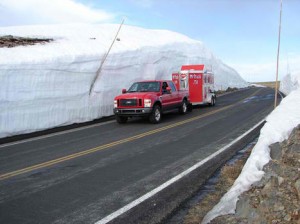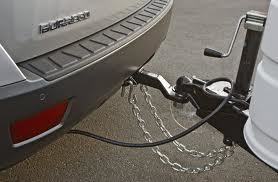Braving Winter Driving With Your Trailer the Right Way
“Whoever said you should let the weather cramp your sense of adventure and thirst to hit the trail? Hitting the road during the winter season is only dangerous at some point if you don’t take the necessary precautions and preparations. So how do you keep yourself safe as you brave the ice? We show you the ways here:“
 Preparing the Trailer:
Preparing the Trailer:
Towing involves a certain set of chores, the most important ones being trailer preparation and maintenance. Besides from keeping yourself safe, following certain measures also clears you from certain laws that can put a damp on your trip when not followed. Below is a list of a pre-trip trailer to-do’s to check off:
- Check wiring and light bulbs
- Spraying all electrical connections with silicon spray
- Fixing (tightening/lubricating) all lug nuts and wheel hubs
- Assessment of tires
- Check locks, chains, bolts, welds, and assembly
- Check trailer and vehicle registrations as well as insurance documents
Dealing with Brakes
Trailering and winter driving involves almost the same skills you practice the entire year except for one factor: braking. The stress and weight of braking should be addressed differently since the road gripping surface during these conditions is not at its optimum. One of the most important nuggets of advice you should follow during when winter driving is to increase the space you need to stop safely.
But what is safe spacing? To determine this, consider how long it would take your vehicle and trailer to stop without the use of brakes. Giving yourself enough distance and leeway to stop during slippery conditions to be safe is important. Using a light touch when hitting the brakes is also essential when winter driving as well since hitting harshly (even with anti-locking braking systems) can lead to skidding and sliding. Keep both hands in the wheel at all times and pump the brake pedal smoothly and in a gradual move while keeping an eye on the trailer to assure that you’re not going into a jack-knife situation with your trailer.
When in manual transmission, remember that downshifting when winter drifting may assist with braking. However, the sudden gear changes also have the possibility of affecting your vehicle’s balance and trailer stability. For more resistance, choose a lower gear on down grades while keeping a watchful eye on the trailer. The careful addition of trailer braking can help in winter driving as well.
 Speed and Vehicle Handling when Winter Driving
Speed and Vehicle Handling when Winter Driving
Winter driving in an aggressive manner is never a good thing due to the added length, weight, stress, and your limited ability to react in certain situations. When traversing highway off-ramps, keep your speed constant and avoid accelerating or braking since even a slight change in the angle of the trailer can lead to jackknifing. Also make it a habit to always anticipate cars coming into your lane from the side-streets. Be always ready to adjust your speed and keep yourself a safe distance from other vehicles. The key in winter driving is to never put yourself in a position that will cause you to make any sudden maneuvering.
Driving with Limited Visibility
Winter driving can be very tricky but several precautions can make it easier for you. The following are just some steps you should follow:
- Before driving, clear snow from the mirrors, windows, windscreen, and roof of the car/truck and the trailer since they can collect a large bulk of snow which can be dangerous for you when they fall.
- Use your low beam headlights.
- Provide enough distance between you and the car in front since braking distances are increased during winter driving conditions.
- Use fog lights when visibility hits below the length of a football field, though make sure to switch them off once visibility improves.
- Use the brake to slow down so that cars behind you can see the lights come on and know that you are planning to change speed.
 Loading Your Trailer
Loading Your Trailer
When loading your trailer, more weight should be placed in front to put 5-15 percent of the total weight on the tow vehicle hitch. Trailers are actually designed and operated in two ways. Those with a weight-carrying hitch have a trailer tongue weight of 10 percent of its total weight while trailers with weight-distributing hitches have tongue weights of 10 to 15 percent of its total weight.
Majority of passenger car and light truck trailer pairs employ weight-carrying hitches. For this type, the load should always be heavier in front with the center of gravity kept low and forward. Heavy items should be placed on the floor of the trailer rather than stacked on top of other items. The heavier the cargo and the trailer are, the greater the weight will be placed directly onto the hitch and rear of the towing vehicle. All goods should be packed firm, close, and secured well.
 What if the trailer is not loaded properly?
What if the trailer is not loaded properly?
The stability of the trailer will be compromised and be hard to control whenever its weight is balanced over its wheels or heavier on its rear rather than on its front. Not loading the trailer properly is one of the leading causes of car-trailer accidents so make it a point to follow rules accordingly. If things feel squirrely and/or the trailer is swaying at all, slow down and pull to a safe place away from traffic if at all possible and re-distribute your trailer load. Then test again to assure you have the most stable truck and trailer load.
Hot tip: Another common problem that motorists encounter during winter is diesel gelling. To make sure you keep your fuel intact, use a fuel additive that can keep it from gelling during low temperatures.
About the Author
Tech Guy
Automotive enthusiast, passionate about Jeeps, hot-rods, turbos, performance, efficiency, diesels, fuels, high performance oils, additives and anything with an engine.

